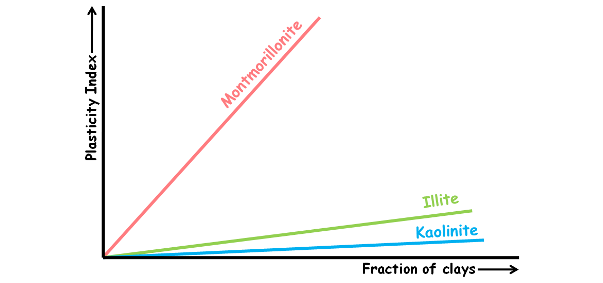Skempton was a civil engineer. Through the lab tests he noticed that plasticity index of soil is directly proportional to the percent amount of the clay sized particles present in the soil.
![]()
Plasticity index is the range of water content in which a soil remains in plastic state and it is defined as difference of soil’s liquid limit and plastic limit.

Liquid limit is the water content of the soil at which soil changes from being in liquid state to plastic state and plastic limit is the water content at which soil changes from being in plastic state to semi-solid state.
Soil is composed of different sized particles. Clay particles are of diameter smaller than two microns. So this is the percent weight of soil, composed of these clay particles by weight of total soil sample.
On the basis of his finding, Skempton defined a soil parameter which he called Activity of soil and defined as the ratio of plasticity index of a soil to the per cent of clay particles by weight in the soil.

We can write it as this

Plasticity index can be written as liquid limit minus plastic limit and both of these can be determined by their respective determining tests. Percent of clay fraction in the soil can be determined by wet sieve analysis.
 Plasticity and the amount of clays present in the soil are related to each other in a way that properties and behaviour of clays are influenced by presence of certain clay minerals. The thickness of the oriented water around a clay particle is dependent on type of clay mineral. Higher the amount of water adsorbing minerals present in the soil higher will be its plasticity. Thus the plasticity of clays depends upon both the nature of clay mineral and the amount of clay mineral present in the soil.
Plasticity and the amount of clays present in the soil are related to each other in a way that properties and behaviour of clays are influenced by presence of certain clay minerals. The thickness of the oriented water around a clay particle is dependent on type of clay mineral. Higher the amount of water adsorbing minerals present in the soil higher will be its plasticity. Thus the plasticity of clays depends upon both the nature of clay mineral and the amount of clay mineral present in the soil.
Hence activity of a soil is also dependent upon both amount and type of clay minerals present in the soil.
We can infer that activity is a measure of water holding capacity of clayey soils.
Based on activity, soils can be classified into three categories

Most of the soils have one of the following clay minerals
- Kaolinite
- Illite
- Montmorillonite
Kaolinite mineral, because of its structure, adsorbs less amount of water. So soils containing kaolinite mineral have very low range of plasticity and low value of activity.
While clay mineral montmorillonite attracts huge amount of water and soils containing montmorillonite, even in very small quantity, have very high value of plasticity range, consequently high value of activity.
Higher activity means high volume change in soil. High volume change means higher compressibility and higher swelling. Higher swelling means high water content adsorption. And soil containing clay mineral montmorillonite adsorbs high amount of water.
Also soils containing mineral montmorillonite exhibit high shrinkage and high swelling characteristics.
We plot a graph between plasticity index and fraction of clays present in the soil.

If we keep on increasing the amount of clay mineral in the soil its plasticity also keeps on increasing. We will notice the graph is straight line and this is what skempton observed, a linear relationship between these two.
These are the graphs of soil containing different types of minerals.
The slope of the line gives the activity of the soil. Steeper the slope greater is the activity. With the increase in the amount of Kaolinite mineral plasticity of soil increases but very little hence activity of such soil is very little.
Soil which contains the monmorillonite shows high plasticity value even with slight increase in its amount.
We can see activity is only defined for soils which contain clay particles. If clay particles in soil are zero then soil’s plasticity will be zero and activity is not defined for that soil.







